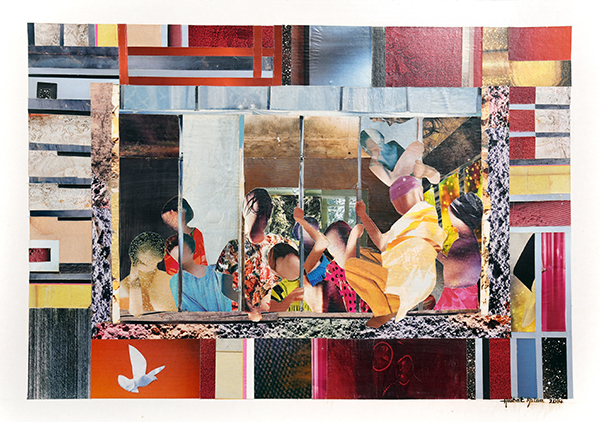A Cut Above
Collage artist and educator, Haibat Balaa, tells ArtScoops about her passion for her media of choice and the work she has prepared for the 8th Beijing International Biennale Exhibition, China, 2019
Collage remains an unusual medium for an artist to work in today. What is it about collage that makes you feel it can best express your ideas?
True, collage remains an unusual media for an artist to work in today and was in the past too. I often wonder why artwork on paper, like watercolour, gouache, ink and collage, is considered cheaper than oil or acrylic on canvas even though it is much more original, time-consuming and unique! Artists find it much easier to draw and paint directly onto paper or on canvas. I have my own way of expressing my concepts, my ideas and feelings through the collage media, which I feel to be totally personal. It is a matter of composing, constructing, planning and displaying fragments to make a united, studied harmonious composition full of expression.
How did you discover collage?
Your process involves assembling and cutting out fragments of paper from everyday life. How do you decide how to utilise the pieces that are at your disposal?
I usually start by sketching the idea that I have in mind, taking account of the rules of design. Then I select the papers - leftovers - that best suit my subject. I start building it, little by little, until it is exactly the same as the original idea that I had in mind. It gives me great pleasure to watch it grow. Sometimes a paperclip could give me an idea for a topic and then other bits gradually complete the idea. When I start working, it flows systematically, as I cut colors, values, intensities and textures, all based on the rules and theories of art that are set deeply in my mind. I cut and assemble fragments of paper from everyday life to suit my topic. Actually, I know every bit of paper I have in my studio and can easily spend hours looking for the exact piece I have in mind for a collage.
You have also worked in other media. Have you ever been tempted to shift your focus more toward watercolours or oils?
I’ve worked with collage, oil painting, watercolor, gouache and ink, and held several exhibitions with watercolor and oil paintings that I called Clones of Collage. However, my collage exhibitions were the most popular and successful because they best reflected my inspiration, interests, pleasure and passion for art.

As an educator do you encourage collage amongst students?
I’ve noticed that it’s difficult to push collage amongst students as our young generation is less patient. Because of the popularity of technology, they may also do collages using Photoshop and be more likely to cut forms and assemble them rather than cutting and creating forms and figures out of textures and motifs. That said, I created a Collage and Assemblage course at the American University of Science and Technology (AUST), where I have been the Fine Arts Coordinator since 2000, with the aim of giving the new generation some of my experience in this domain.
What can you tell us about the collection of work that you’re presenting at the 8th Beijing International Biennale Exhibition, China, 2019 which opens at the end of August?
The collage that I will be showing at the biennale is named ‘Future Leaders’, in line with the title of the Biennale, which is ‘A Colorful World and a Shared Future’. My collage represents a group of four 14-year-old boys, each holding a book and sitting in the dark. They are seeking and dreaming of the light which is approaching in the distance. In this piece of art, I used silkscreen prints, etching prints, calligraphic prints, gouache and watercolor paintings, all of which I found suitable to express my idea and my inspiration.


